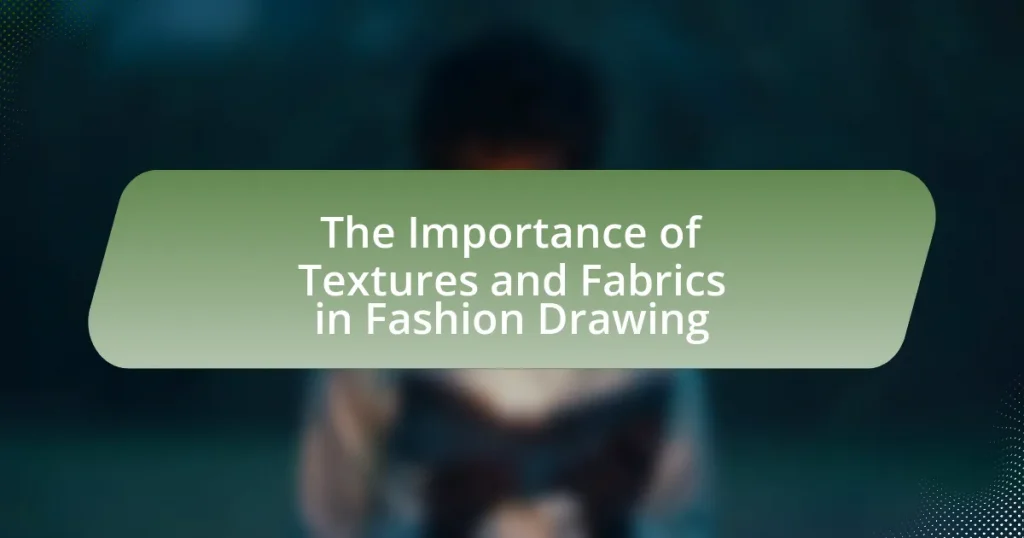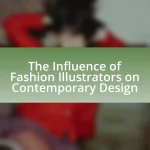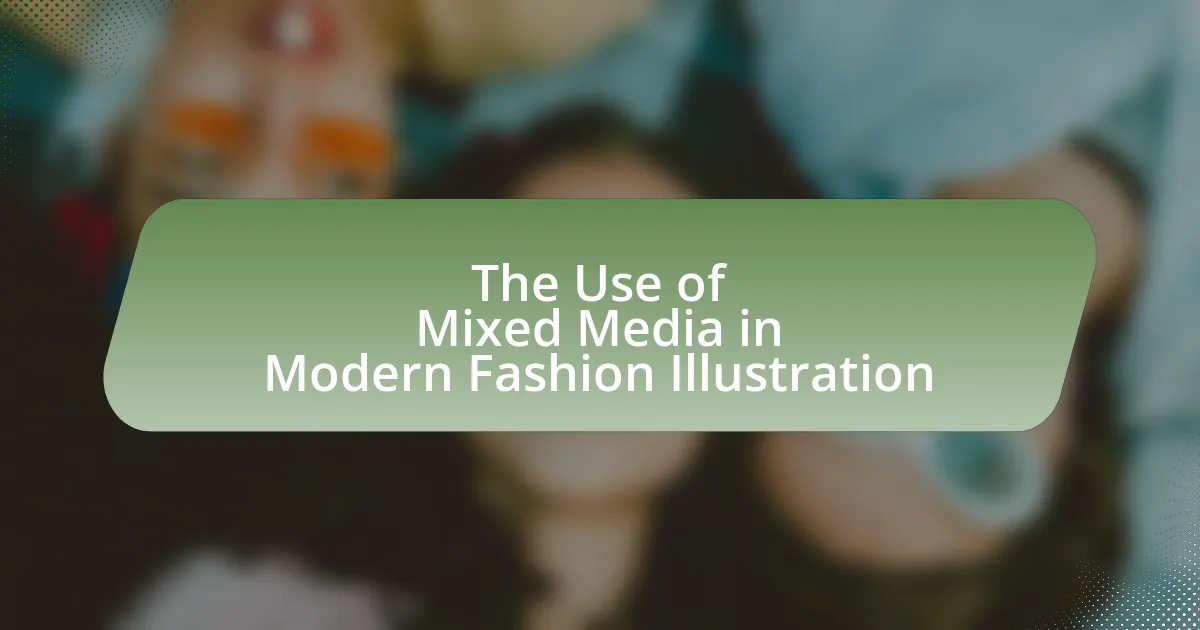The article focuses on the significance of textures and fabrics in fashion drawing, highlighting their role in conveying tactile qualities and visual characteristics of garments. It discusses how textures and fabrics influence the design process, emotional perception, and consumer attraction, emphasizing their importance in effective fashion communication. The article also explores techniques for representing textures in illustrations, the impact of contemporary trends on fabric choices, and practical tips for artists to enhance their skills in depicting various materials. Additionally, it addresses the latest innovations in fabric technology and their implications for fashion design.
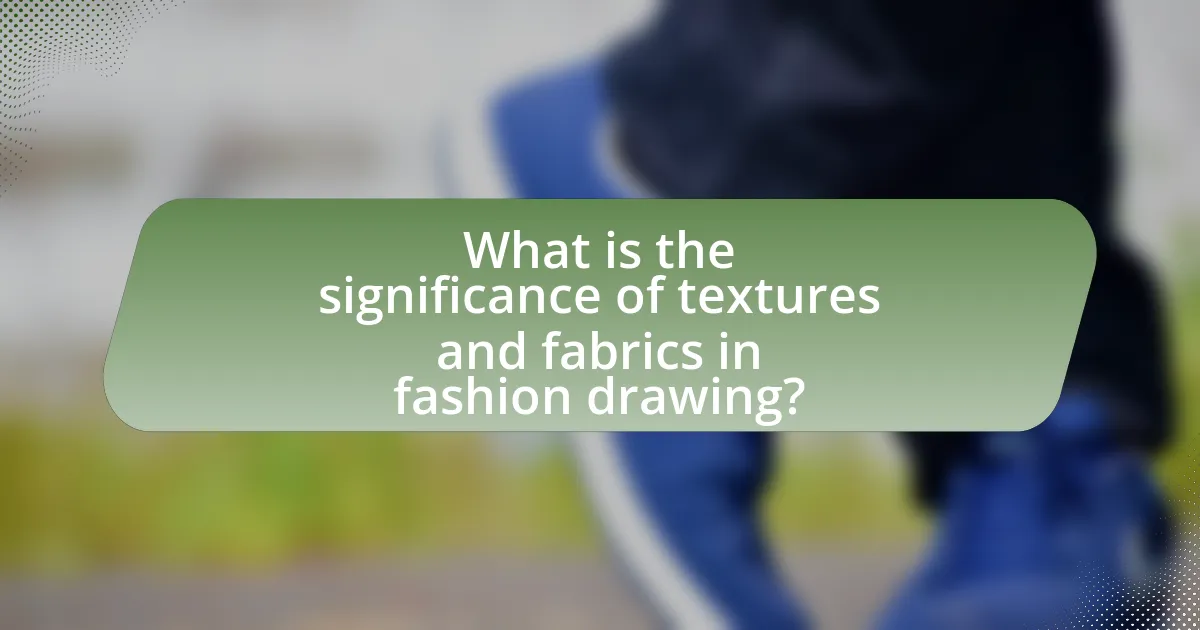
What is the significance of textures and fabrics in fashion drawing?
Textures and fabrics are crucial in fashion drawing as they convey the tactile qualities and visual characteristics of garments. By representing different materials, such as silk, denim, or wool, artists can communicate the intended feel and drape of the clothing, which influences the viewer’s perception of the design. For instance, the use of shading techniques can mimic the sheen of satin or the roughness of burlap, enhancing the realism of the illustration. This attention to detail not only aids in the design process but also helps potential buyers visualize the final product, making textures and fabrics integral to effective fashion communication.
How do textures and fabrics influence the overall design process?
Textures and fabrics significantly influence the overall design process by dictating the aesthetic, functionality, and emotional impact of a design. Designers select specific textures and fabrics to convey particular themes and styles, as different materials evoke distinct feelings and associations; for example, silk suggests luxury while denim implies casualness. The choice of fabric also affects the garment’s drape, fit, and movement, which are crucial for achieving the desired silhouette and comfort. Furthermore, the tactile quality of fabrics can enhance user experience, as seen in studies showing that consumers often prefer products that feel good to the touch, impacting purchasing decisions. Thus, the integration of textures and fabrics is essential in shaping the visual and sensory aspects of fashion design.
What role do textures play in conveying emotions in fashion illustrations?
Textures play a crucial role in conveying emotions in fashion illustrations by enhancing the visual narrative and evoking specific feelings. Different textures, such as smooth silk or rough denim, can symbolize various emotional states; for instance, soft textures often suggest comfort and warmth, while harsh textures may evoke feelings of toughness or rebellion. Research indicates that the tactile quality of materials influences viewer perception, as textures can trigger emotional responses based on cultural associations and personal experiences. Thus, the strategic use of textures in fashion illustrations not only enriches the aesthetic appeal but also deepens the emotional connection between the artwork and the audience.
How do different fabrics affect the perception of a design?
Different fabrics significantly influence the perception of a design by altering its texture, drape, and overall aesthetic appeal. For instance, lightweight fabrics like chiffon create a soft, flowing silhouette that conveys elegance, while heavier materials such as denim project durability and a casual vibe. Research indicates that fabric choice can evoke specific emotional responses; for example, silk is often associated with luxury and sophistication, whereas cotton is linked to comfort and everyday wear. This relationship between fabric and perception is crucial in fashion design, as it directly impacts consumer attraction and brand identity.
Why are textures and fabrics essential for fashion designers?
Textures and fabrics are essential for fashion designers because they significantly influence the aesthetic, functionality, and overall appeal of garments. The choice of texture and fabric affects how a design is perceived, as different materials can convey various emotions and styles; for instance, silk often suggests luxury, while denim implies casualness. Additionally, the physical properties of fabrics, such as drape, weight, and stretch, directly impact the fit and movement of clothing, which is crucial for both design integrity and wearer comfort. Historical context supports this, as the evolution of fashion has been closely tied to advancements in textile technology, with innovations like synthetic fibers expanding creative possibilities for designers.
What are the key benefits of incorporating textures in fashion drawings?
Incorporating textures in fashion drawings enhances visual realism and communicates the tactile qualities of fabrics. Textures allow designers to convey how materials will look and feel, influencing consumer perception and decision-making. For instance, a study published in the Journal of Fashion Marketing and Management found that visual texture representation significantly affects the viewer’s emotional response and product desirability. By integrating textures, fashion illustrations become more engaging and informative, ultimately aiding in the design process and marketing strategies.
How do fabrics contribute to the storytelling aspect of fashion design?
Fabrics significantly contribute to the storytelling aspect of fashion design by conveying emotions, cultural narratives, and thematic elements through their textures, colors, and patterns. For instance, luxurious silks can evoke feelings of elegance and sophistication, while rougher materials like burlap may suggest rustic or earthy themes. Historical context also plays a role; fabrics such as denim have become symbols of rebellion and youth culture since the 1950s. Additionally, designers often select specific fabrics to align with the narrative of their collections, as seen in collections that utilize sustainable materials to tell stories of environmental consciousness. This intentional choice of fabric enhances the overall narrative, making the fashion piece not just a garment but a medium for storytelling.
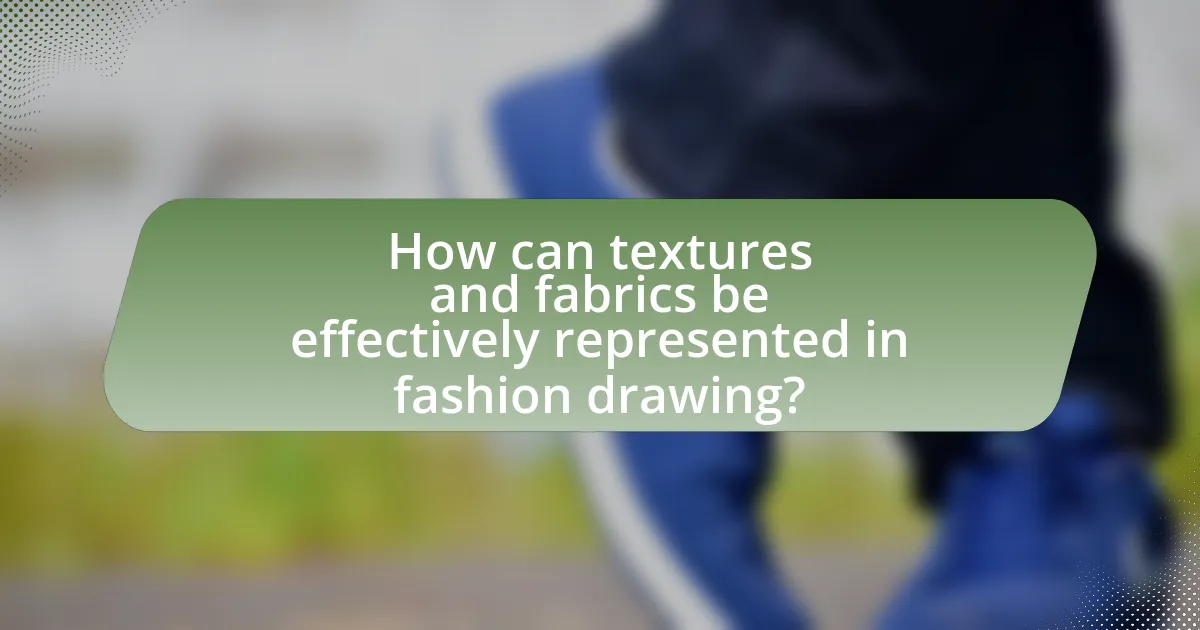
How can textures and fabrics be effectively represented in fashion drawing?
Textures and fabrics can be effectively represented in fashion drawing through the use of various techniques such as shading, line work, and color application. Shading techniques, including cross-hatching and stippling, can create depth and dimension, mimicking the way light interacts with different materials. Line work can vary in thickness and style to suggest the texture of fabrics, such as smooth silk or rough denim. Additionally, color application can reflect the inherent qualities of materials; for instance, using glossy finishes for satin or matte tones for cotton can enhance the visual representation of the fabric. These methods are supported by the principles of visual perception, which indicate that texture representation relies on the viewer’s ability to interpret visual cues effectively.
What techniques can artists use to depict different textures?
Artists can use techniques such as layering, stippling, and cross-hatching to depict different textures effectively. Layering involves applying multiple layers of paint or pencil to create depth and richness, which can simulate the appearance of materials like fabric or skin. Stippling, the technique of using small dots to build up texture, can represent rough surfaces like stone or foliage. Cross-hatching, which consists of intersecting lines, can convey the softness of textiles or the hardness of metal. These techniques are widely recognized in art education and practice, as they allow artists to create realistic representations of various textures, enhancing the visual impact of their work.
How does shading enhance the representation of fabric textures?
Shading enhances the representation of fabric textures by creating depth and dimension, which allows viewers to perceive the material’s characteristics more accurately. Through techniques such as gradient shading and highlighting, artists can simulate the way light interacts with different fabrics, revealing qualities like softness, sheen, and weight. For instance, a satin fabric appears glossy and smooth due to reflective highlights, while a rough fabric like burlap is depicted with more muted tones and sharper contrasts to convey its texture. This visual differentiation is crucial in fashion drawing, as it helps communicate the intended feel and drape of the garment, ultimately influencing the viewer’s understanding of the design.
What tools are best for illustrating various fabric types?
The best tools for illustrating various fabric types include markers, colored pencils, and digital illustration software. Markers provide vibrant colors and can mimic the sheen of fabrics like silk, while colored pencils allow for detailed texture representation, ideal for materials such as wool or denim. Digital illustration software, such as Adobe Illustrator or Procreate, offers versatility and precision, enabling artists to create realistic fabric textures through layering and blending techniques. These tools are widely used in fashion design to accurately depict the unique characteristics of different fabrics, enhancing the overall visual appeal of fashion drawings.
What common mistakes should be avoided when illustrating textures and fabrics?
Common mistakes to avoid when illustrating textures and fabrics include neglecting to study the material’s properties, which can lead to inaccurate representations. For instance, failing to understand how light interacts with different fabrics, such as the sheen of silk versus the matte finish of cotton, results in misleading illustrations. Additionally, using a single technique for all textures, like relying solely on cross-hatching, can oversimplify complex surfaces. Observing real-life examples and practicing various techniques tailored to specific materials enhances accuracy and depth in illustrations.
How can over-exaggeration of textures impact the design?
Over-exaggeration of textures can lead to a chaotic and visually overwhelming design, detracting from the intended aesthetic and functionality. When textures are exaggerated beyond a harmonious balance, they can create confusion in the viewer’s perception, making it difficult to focus on the overall design concept. For instance, in fashion design, excessive texture can overshadow the silhouette and form of the garment, leading to a loss of clarity in the design’s message. This phenomenon is supported by design principles that emphasize the importance of balance and unity; when one element is overly dominant, it disrupts the visual hierarchy and can alienate the audience.
What are the pitfalls of not understanding fabric properties in drawings?
Not understanding fabric properties in drawings can lead to significant design flaws and misrepresentations. Designers may inaccurately depict how a fabric drapes, stretches, or behaves under different conditions, resulting in garments that do not fit or function as intended. For instance, failing to recognize that silk has a different weight and flow compared to cotton can lead to unrealistic expectations in the final product. This misunderstanding can also affect the choice of colors and patterns, as certain fabrics may alter the appearance of hues due to their texture and sheen. Ultimately, these pitfalls can result in wasted resources, increased production costs, and diminished consumer satisfaction, as the final garments may not align with the designer’s vision or the client’s needs.
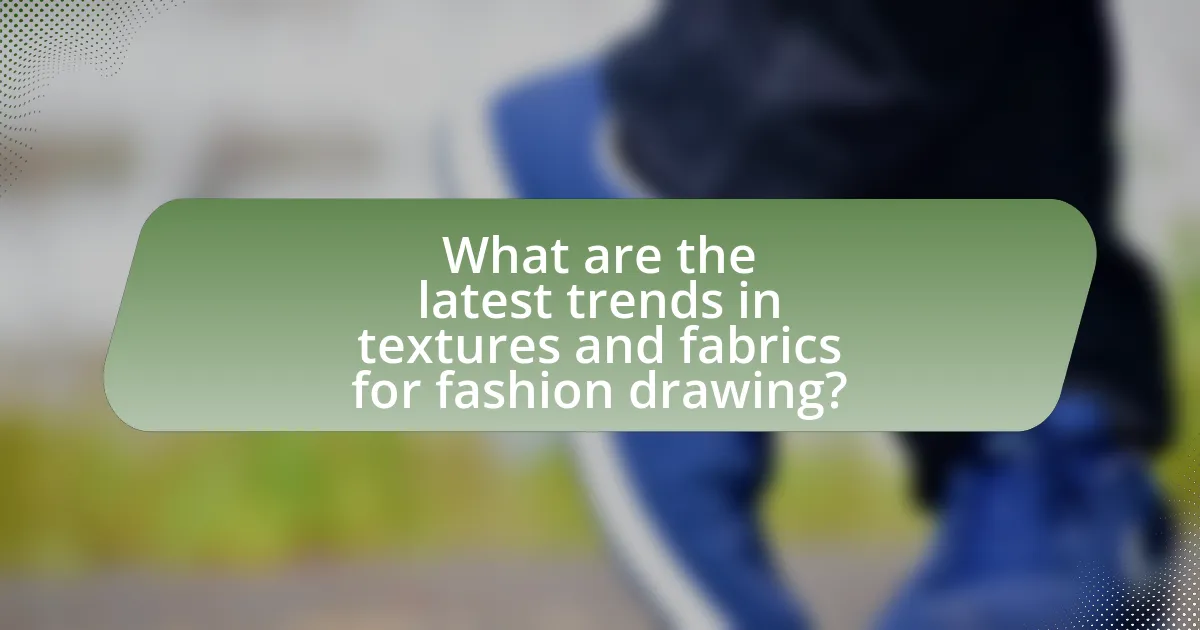
What are the latest trends in textures and fabrics for fashion drawing?
The latest trends in textures and fabrics for fashion drawing include the use of sustainable materials, digital prints, and mixed media techniques. Sustainable fabrics, such as organic cotton and recycled polyester, are increasingly favored due to the growing emphasis on eco-friendly fashion. Digital prints allow for intricate designs and vibrant colors, enabling designers to experiment with patterns that were previously difficult to achieve. Additionally, mixed media techniques, which combine various textures like leather, lace, and knits, are gaining popularity as they add depth and dimension to fashion illustrations. These trends reflect a shift towards innovation and sustainability in the fashion industry.
How are digital tools changing the representation of textures in fashion illustrations?
Digital tools are revolutionizing the representation of textures in fashion illustrations by enabling artists to create highly detailed and realistic fabric representations. These tools, such as graphic design software and digital painting applications, allow for precise manipulation of color, shading, and patterns, which enhances the visual depth and tactile quality of textures. For instance, programs like Adobe Photoshop and Procreate offer features like layering, blending modes, and texture brushes that facilitate the simulation of various fabric characteristics, such as sheen, softness, and weave. This technological advancement not only improves the accuracy of texture representation but also expands creative possibilities, allowing illustrators to experiment with innovative designs and styles that were previously challenging to achieve with traditional methods.
What innovations in fabric technology are influencing fashion drawing?
Innovations in fabric technology, such as 3D printing, smart textiles, and sustainable materials, are significantly influencing fashion drawing. 3D printing allows designers to create intricate patterns and structures that were previously impossible, enabling more detailed and imaginative sketches. Smart textiles, which incorporate electronics and sensors, provide dynamic visual elements that can be represented in fashion drawings, showcasing how garments can interact with the environment. Additionally, the rise of sustainable materials, like recycled fabrics and bio-based textiles, encourages designers to explore eco-friendly aesthetics, which can be reflected in their drawings. These advancements not only enhance the creative process but also align with contemporary trends in sustainability and technology in the fashion industry.
How do contemporary trends affect the choice of textures in fashion design?
Contemporary trends significantly influence the choice of textures in fashion design by prioritizing sustainability, comfort, and technological innovation. Designers increasingly select eco-friendly materials, such as organic cotton and recycled polyester, reflecting a growing consumer demand for sustainable fashion. For instance, a 2021 report by McKinsey & Company highlighted that 67% of consumers consider the use of sustainable materials as important when making fashion purchases. Additionally, the rise of athleisure has led to a preference for soft, stretchy fabrics that enhance comfort while maintaining style. This trend is supported by the popularity of brands like Lululemon, which emphasize performance textiles. Furthermore, advancements in textile technology, such as 3D printing and smart fabrics, allow designers to experiment with unique textures that were previously unattainable, thus expanding creative possibilities in fashion design.
What practical tips can enhance the representation of textures and fabrics in fashion drawing?
To enhance the representation of textures and fabrics in fashion drawing, artists should utilize varied line techniques, shading, and color choices. Employing different line weights can simulate the feel of fabric, such as using fine lines for delicate materials like silk and bolder lines for heavier fabrics like denim. Additionally, incorporating shading techniques, such as cross-hatching or stippling, can create depth and dimension, mimicking the way light interacts with different textures. Color choices also play a crucial role; using a palette that reflects the fabric’s properties—like muted tones for wool or vibrant hues for satin—can further enhance realism. These methods are supported by studies in visual perception, which indicate that texture representation significantly influences the viewer’s understanding of material properties in art.
How can artists practice effectively to improve their texture illustration skills?
Artists can practice effectively to improve their texture illustration skills by engaging in focused exercises that emphasize observation and replication of real-world textures. This includes studying various materials, such as fabric, wood, and metal, and creating detailed sketches that capture their unique characteristics. Research indicates that artists who regularly practice observational drawing can enhance their ability to depict textures accurately, as demonstrated in studies by the University of the Arts London, which found that consistent practice leads to improved visual perception and representation skills. Additionally, utilizing digital tools and techniques, such as texture brushes in software like Adobe Photoshop, allows artists to experiment with different styles and effects, further refining their skills.
What resources are available for learning about fabric types and textures?
Books, online courses, and textile museums are valuable resources for learning about fabric types and textures. Books such as “Fabric for Fashion: The Swatch Book” by Clive Hallett and Amanda Johnston provide comprehensive insights into various fabrics and their characteristics. Online platforms like Coursera and Udemy offer courses specifically focused on textiles, covering topics from fabric identification to texture application in design. Additionally, visiting textile museums, such as the Textile Museum in Washington, D.C., allows for hands-on experience with different fabrics and textures, enhancing understanding through direct observation.
